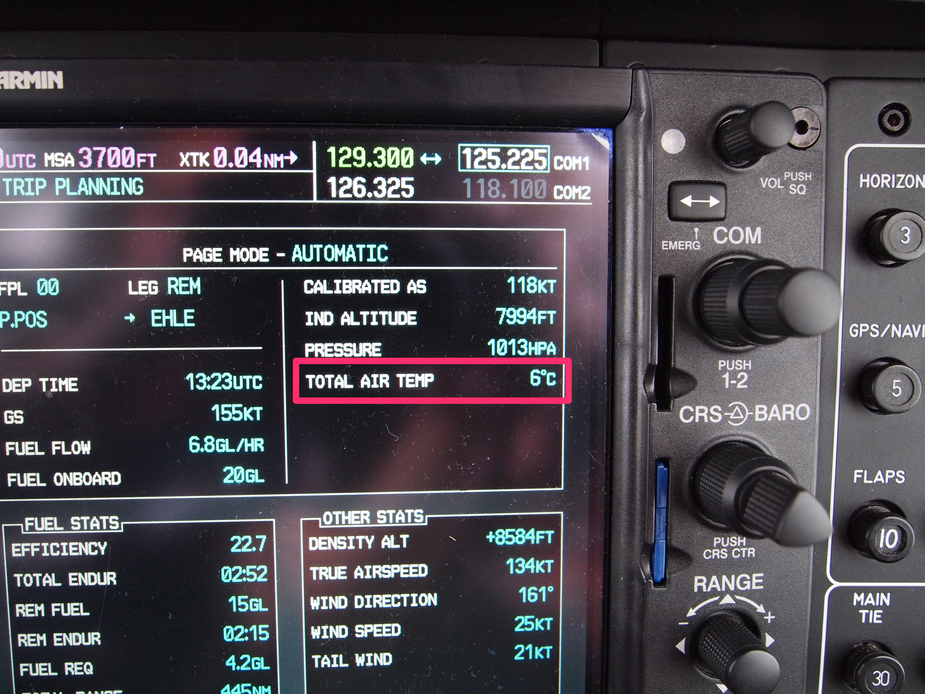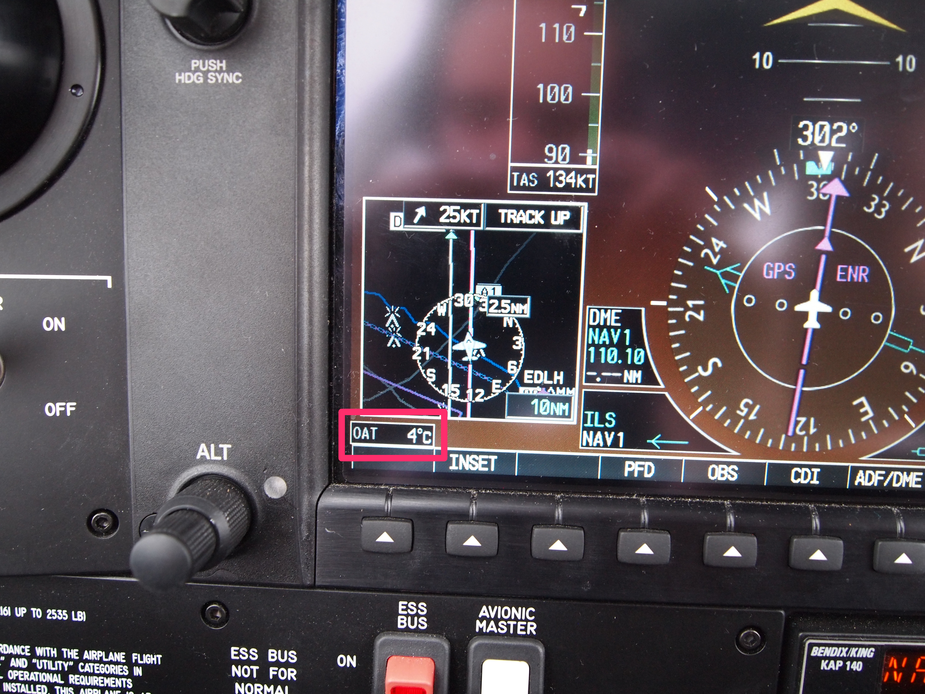The G1000 in our aircraft displays the OAT on the PFD.
In the Stats Page on the MFD also the TAT (Total Air Temperature) is shown. This is the actual temperature as measured by the temperature probe.
It’s showing a higher value then the OAT because of aerodynamic heating.
Is there any value in knowing the TAT?
Would you get icing when the OAT is sub-zero but the TAT is above zero °C ?
Total Air Temperature as shown on the stats page:

OAT as shown on the PFD:

OAT is a normal outside static temperature.
TAT is OAT plus the dynamic heating due to compression of air as it is brought to rest. Kinetic heating or RAM rise.
TAT is generally used to calculate OAT/SAT using TAT rise formulas or to calculate TAS.
For ice protection you want to be referring to OAT as G1000 has already converted those values.
The Mustang shows RAT on the PFD rather than OAT. This is TAT but not adjusted for instrument error (not capturing all of the compressibility effect). The faster you go, the more important calculating TAT (or RAT) as that is what affects engine performance and icing.
Over at Pprune (in the R&N section) there was quite a discussion regarding this in relation to the BA08 (the 777 that turned into a glider at LHR) incident. Perhaps have a look at that old thread, should still be there.
Is there any value in knowing the TAT?
In light GA that’s a really good question. At 150kt TAS the temp rise due to compression is around 2C. It is logarithmic and at higher speeds it goes up rapidly e.g. at 350kt TAS it is 15C so a 350kt TAS aircraft should almost never get airframe icing (in stratus cloud).
The 2C temp rise is similar to what a standard GA OAT probe sees

so I would argue that computing TAT is of little value because your existing OAT probe is already showing TAT. If you fly in level flight, in hopefully uniform air, and you bring the speed up from Vs to whatever max you can get, you see this temp rise on the OAT probe.
I wrote to Shadin (who make the popular ADC200 etc – an airdata computer box which takes in the pitot and static pressures, the heading, the OAT from its own OAT probe, and computes the TAT, TAS and the wind vector) asking this but they avoided giving a straight reply, which I suspect is because the ADC200 TAT generation doesn’t actually do anything useful at “our” speeds.
Would you get icing when the OAT is sub-zero but the TAT is above zero °C ?
Definitely. A 350kt TAS aircraft flying in -5C SAT will see about +10C TAT.
In really marginal cases, you could be flying at -1C SAT (static air temperature) and if you can squeeze say 180kt TAS out of your plane, you will be nicely above the 0C freezing situation. But that (icing risk) implies flying in IMC and there you probably want to be below Va, in case you go into something convective. So I don’t think this is a useful technique. In large jets, Va is not far short of cruise speed so they can fly in IMC and with approprite use of radar they can just go through convective stuff.
There are various online calculators for generating TAT from SAT, IAS, temp, etc e.g. here The old Jepp CR-5 circular slide rule does it very quickly too – it’s about the only thing I ever used mine for.
Definitely. A 350kt TAS aircraft flying in -5C SAT will see about +10C TAT.
This can be a bit of a gotcha – if you are belting down at 300 KIAS with a TAT of say +12 and in IMC. then slow down to 250 as you descend through FL100 you need to put the anti-ice on as you will be dropping into icing conditions!
I’m a geek – I still carry a CRP5 in my flight bag as it can do calculations quicker than faffing around with Pilotwizz or your app of choice.
thelenthamen wrote:
Would you get icing when the OAT is sub-zero but the TAT is above zero °C ?
I’m confused by Peter’s and Evo400’s replies. My understanding is that you do NOT get icing when the aerodynamic heating brings the temperature above freezing, which it should do when the TAT is above 0°C. Josh seems to agree.
I think it’s possible. Not every part of the airframe is going to be experiencing the same kinetic heating and therefore in specific circumstances you might be able to ice up a bit when the TAT probe is telling you its +2 or something. I would say it’s not common though, but it should be considered. Boeing say that anti ice should be used if the TAT is below 10 in visible moisture. (although they make references to SAT and OAT for other things just to keep you thinking)
My understanding is that you do NOT get icing when the aerodynamic heating brings the temperature above freezing, which it should do when the TAT is above 0°C
Yes that is correct.
But, at higher speeds (jets) you can have one bit of an airframe say 10C above or below another bit, due to local airflow pressure variations.
I have a couple of ADC200s on the shelf and was going to install one, one day, just for fun. You can get a wind vector on a Garmin GPS, and probably also on the IFD540.
Airborne_Again: you are correct with your statement.
I was referring to a light GA aircraft as I doubt you will see those kind of high TAS speeds so OAT is more reliable, rather then thinking we wont pick up as ice as TAT is +2 and oat is zero.